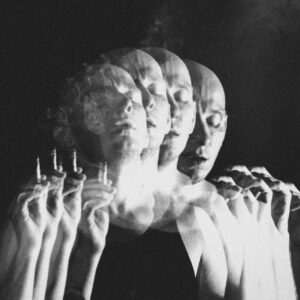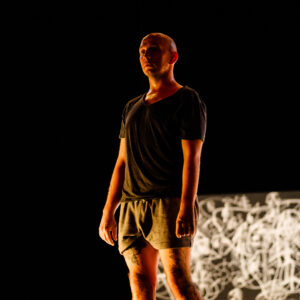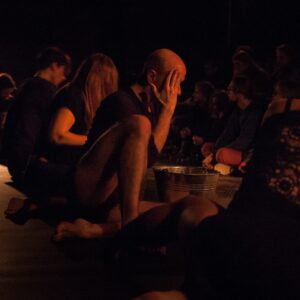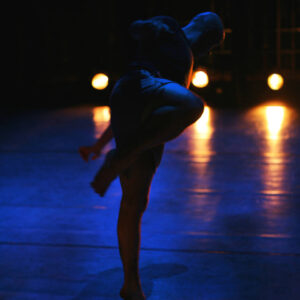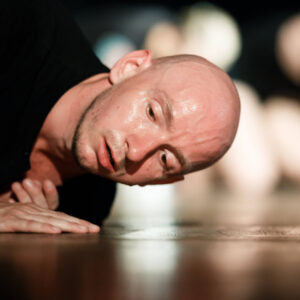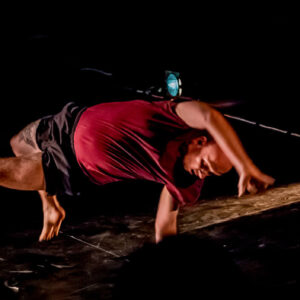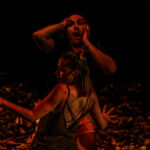Everything reminds me of dance
Interview with Marek Zadłużny
My perspective has changed. I grow up and so does my work. Currently, I think a lot about the audience, the potential viewer with whom I want to communicate through choreography. Without it, theater does not exist, so I often talk about it and discuss it with other artists. Dance theater cannot be "detached". It should be available to an ordinary viewer, that is, someone who is not specially prepared to receive this field of art.
Agnieszka Moroz from Dziennik Teatralny talks to Marek Zadłużny, founder, artistic supervisor and choreographer of the Dance Theater Studio in Zielona Góra.
Agnieszka Moroz: In a country where theaters go to the theater mainly by name, they watch dance almost exclusively in music videos, "Dancing with the stars" or "You Can Dance", and where over 60% of citizens regularly declare that last year have not read a single book, you have decided to take up dance theater, which in addition draws considerable inspiration from literature. Where did this idea come from?
Marek Zadłużny : My interest in dance theater results from the fact that I have always been interested in the body in motion. When I was a little boy, I was fascinated by eastern martial arts and passionately watched all the movies in which there were fighting scenes. The more spectacular, I would say re-graphed, the more intrigued me. I watched the same movies over and over again. In hindsight, I think it was a bit weird. I guess that's what I have been left with, that if I like something, I'm not bored at all. It doesn't matter if it's a movie, song, work, person ...
I come from the small town of Pełczyce, where as a child I did not have the opportunity to educate myself in dance. It was only in high school that I found my way to the amateur theater "Windmill" in Barlinek and there I started my path of artistic development. It was also there that I first encountered contemporary dance, improvisation, conscious movement. is what I want to do. You could say that I fell in love with dance, and because I grew up in the theatrical tradition, went to festivals, participated in workshops and communed with the theater of the word, it was natural for me to combine these two worlds. I was an enthusiast of the dramaturgy of the spoken word, so I decided to communicate with the viewer non-verbally. It was quite easy for me to create a story,building architecture or stage tissue through movement and dance. I knew what effect I wanted to get. I have always had a deep feeling that all areas of art intertwine, that they can mix, that you can mix various means of expression and forms of expression, use multimedia, reach for the aesthetics of kitsch, draw infinitely many inspirations from literature, film or visual arts. As long as you have an open mind. Only later did I understand that I meant syncretism in art, although I could not name it then. But I found out about it already during my studies of cultural animation in Zielona Góra. It was a good time. Lots of meetings. Time for making friends, communing with artists. Many watched performances, artistic experiments, workshops, borderline activities, trips to festivals.It all shaped me and influenced the aesthetics that I use today in my dance theater. After graduation, in 2009, I started working as a choreographer, and a year later I founded my artistic child - the Dance Theater Studio.
Agnieszka Moroz: Your friends call you Apollo. The comparison to the patron of art and the guide of the Muses seems accurate - you infect more and more people with your passion for dance and creative energy who decide to follow you. And who led you? Did you have your helmsmen at the beginning of the journey who gave you strength?
Marek Zadłużny: The story with Apollo is that we once invented an action in a collective to give ourselves a second name related to Greek mythology, and then Apollo appeared. Some people have given up on it, but this Apollo suits me very well. It does not offend me when I see this name, e.g. on Facebook. The patron of the arts and guide of the Muses is a great affirmation. In general, I think that words create reality, so you should affirm positively, build an invisible shield, for example in the form of a name derived from a Greek god. There are too many negative emotions around us and people who love to sting. I can see it especially in the art world, where you create and expose yourself to criticism.
When it comes to mentors, a few significant people have appeared on my way. For example Marta Zmarzlik (now Grygier), who showed me the world of dance for the first time at the Wiatrak Theater and aroused my interest in dance theater. For many years my teacher in Zielona Góra was also Małgorzata Konert (now Chreptak), to whom I owe my systematic training and embedding my body in the modern dance technique, which is a great achievement, considering that I only started dancing at the age of seventeen. Later I met Anna Piotrowska (currently the manager of the artistic team at the Rozbark Dance and Movement Theater in Bytom). I took part in workshops and choreography laboratories organized by her in Warsaw and Kashubia. Conversations with her shaped my perception of choreography as a dramatic whole,which is not a coincidence, but an impression, closed as a whole, a spectacle-message, being the result of a common intellectual process taking place between the choreographer and the dancers.
For several years, my creative and choreographic work has been strongly influenced by learning about the work method created by Ohad Naharin, director of the Batsheva Dance Company in Tel Aviv. It is about the language of the movement, which is GaGa (recently it has become famous thanks to the biographical film about Ohada entitled "Mr. GaGa", which was released in Polish cinemas in March). This method turned out to be extremely close to my thinking about dance. It was a breakthrough discovery for me due to the way I understand movement, its interpretation, physical contemplation and focus on enjoying dancing. Because I like to dance and move most of all. It gives me joy, which I try to pass on to others. I do not fully understand. the philosophy that sweat comes first in dance, then pain and blood, then beauty.
Agnieszka Moroz: You are the founder and leader of the Dance Theater Studio in Zielona Góra, with which you have already staged over a dozen performances. What does your work on developing individual performances look like?
Marek Zadłużny: Our creative work begins with completing the cast for a given project. Later, I propose a theme and a general outline of the aesthetics in which I would like to build a performance. Sometimes this topic comes up by itself. Naturally - from discussions during trips to festivals. It is the result of being together a lot. When I think about it now, I have the impression that I never stop the process of looking for inspiration, creating. Everything reminds me of dance. It's something I can't turn off in my head. Action in the background, which can be even tiring ... Our performances are built in the process of exchanging thoughts and ideas between the dancers and me. When working with me, every dancer has a chance to become an active artist. I am open to his suggestions and ideas. People are a great inspiration to me. They give me a lot.That is why the cast is so significant. We create a closed space of creation, a group that has its own dynamics. Each personal change has an impact on creative work, which may sound a bit metaphysical, but it is. All of this cannot be clarified in an interview (although I suspect that it would be a good idea for a research paper describing group creative processes). I call myself the artistic supervisor of the implemented projects. So I take responsibility for what will be presented to the audience and I make the final decisions regarding the choice of music, exhausting the topic, and specific components of the choreography. At the same time, however, I feel that we are growing together. We grow and we push each other in this development. Three years ago I made a decision to change my work model - from age-matched groups to design work.It was my best decision. Now we form one team, varied in age, but thanks to this diversity, everyone learns from each other. Anyway, there is simply no age difference between us. I think we've become similar to each other [laughs], although of course the situation between us is not like candy. I would rather describe it as dynamic. We just exchange energies. Everyone is an individual in the team. On average, we create about three performances per season - two group works and a duo or a smaller form. As for the method, we generally work on the basis of structural improvisation. My performances are not choreographed in the classical and traditional sense. In communicating with the dancers, I use mental shortcuts, certain terms for what I would like to get on stage.To an outside observer, this might seem totally abstract, because I am talking about intentions or emotions that I expect in motion, but I do not choreograph dancers. I build on their potential and release it in them. The more I can do it, the better for the show. Of course, apart from creative work, there is also a workshop sphere. I teach dance techniques several times a week. Some of the people who are now in the repertoire group started to dance under my supervision. The progress they have made has been extremely encouraging. We are also assisted by pedagogues and choreographers, whom we invite to cooperate or conduct workshops with our team. So we draw from many sources.The more I can do it, the better for the show. Of course, apart from creative work, there is also a workshop sphere. I teach dance techniques several times a week. Some of the people who are now in the repertoire group started to dance under my supervision. The progress they have made has been extremely encouraging. We are also assisted by pedagogues and choreographers, whom we invite to cooperate or conduct workshops with our team. So we draw from many sources.The more I can do it, the better for the show. Of course, apart from creative work, there is also a workshop sphere. I teach dance techniques several times a week. Some of the people who are now in the repertoire group started to dance under my supervision. The progress they have made has been extremely encouraging. We are also assisted by pedagogues and choreographers, whom we invite to cooperate or conduct workshops with our team. So we draw from many sources.whom we invite to cooperate or conduct workshops with our team. So we draw from many sources.whom we invite to cooperate or conduct workshops with our team. So we draw from many sources.
Agnieszka Moroz: What kind of reception do your performances meet? Does the way you perceive them affect the shape you give to your next performances?
Marek Zadłużny: The aesthetics of our shows has evolved. I guess I was a bit more rebellious at first and some of our projects went against the tide. For example, "Chasing cormorants" - a spectacle referring to the theme of gender, "Lullaby" in which we break eggs or "Femini_kan" in which nudity appears. When these performances were made, I was 25-26 years old, and now I am 32. My perspective has therefore changed I grow up, and so does my work. Currently, I think a lot about the audience, the potential audience with whom I want to communicate through choreography. Without it, theater does not exist, so I often talk about it and discuss it with other artists. Dance theater cannot be "detached". It should be available to an ordinary viewer, that is, someone who is not specially prepared to receive this field of art.I often get the impression that dance theater is such a niche space that the audience consists mainly of other dancers and artists. Meanwhile, the audience is very important for the development of dance theater in Poland. This foundation should be solid and it is in the interest of all creators to care for it. So I always start by asking myself, “Why am I dancing? What am I dancing about? Who am I dancing for? ”They organize this sphere, discipline.
Currently, I am focused on socially engaged projects and critical choreography, but I have learned to use a language that is understandable even to a random viewer who, for example, suddenly "enters" our outdoor performance. Multiple levels of interpretation, using emotions, images and music allow our team create worlds that reach different audiences - this is probably why we do not complain about the lack of it. We meet rather positive, enthusiastic reception, even though we do not entertain and tell light stories. We have managed to develop a characteristic aesthetics, a physical language of communication with the viewer. In my work, in movement and in dance, I am always looking for the truth, however abstract it sounds, and it seems to me that this authenticity defends itself.
Agnieszka Moroz: As a band, do you have your own "safety zone" that you would not decide to go beyond? Are there topics or techniques that you would definitely not reach for?
Marek Debłużny: I am not a fan of unjustified turpism and shocking on stage. On the other hand, minimalism appeals to me. I know that these concepts are blurry and you can have an academic discussion about what beauty is and isn't in art, where dance begins and movement ends, etc. These limits depend on the context in which they are applied. This one, however, has to work. You can write a lot about your ideas, embed them in theoretical grounds, various concepts of creative work, but if they do not affect the viewer, it means that the idea simply did not work out. Certainly there are spaces that are especially close and natural to me. Structural improvisation, repetitions, deliberate repetition, strong, physical movement, dynamics, falls, animalism, specificity of the topics I am talking about. Certainly, by creating a dance theater,I am looking for a space to use dance in theater. I try to make it adequate, resonate, be "to the point". So that it does not act as an empty tool for the choreographer and dancers, it is not pure entertainment, it does not appear solely for autotelic reasons. The dance in my projects cannot be treated instrumentally. For me, it is a philosophy and contemplation. But someone may think differently and I respect it. Unfortunately, I have the impression that mutual respect and acceptance in the dance world is a deficit. This environment seems to be very different, and I do not mean only artists, I am also talking about theoreticians, the whole community. As a critical researcher dealing with the culture of dance also in theory, this is how I see it. In particular, there is a lack of respect for diversity;which is called artistic dance in Poland, but I do not want to develop this thread, because it is a topic for a separate conversation. However, the socio-cultural reality is dynamic, the world of dance is changing just as dynamically and it may change soon. After all, new people are appearing all the time, with fresh energy. I wish everyone well. For me, dancing is freedom and truth. I know this may seem trivial, over-symbolization, but I really find it in him.over-symbolization, but I really find it in him.over-symbolization, but I really find it in him.
Coming back to the topic - I am open to all forms of stage expression. Their use, however, must be justified and grounded in an appropriate context. I am a performing arts enthusiast. During classes with students of culture animation at the University of Zielona Góra, when I talk about dance in culture, I show them a documentary about Marina Abramowic "The Artist is Present". I think it helps to catch a broad perspective in the reception of art. Understanding that nowadays dance theater and contemporary dance are a complex of phenomena and phenomena that are manifested in culture and are inter- and transdisciplinary in nature, present not only in the spaces traditionally assigned to dance, but I mean that these boundaries exist only in our heads and we, the people of dance, sometimes create harmful labels.“This is dance, and that's not anymore. This is good now, and it used to be. "Some people give their opinion without even seeing a performance. And doesn't good art defend itself?
Agnieszka Moroz: In mid-March I participated in the Sfera of Movement - a dance theater festival that you organize under the auspices of the Youth Center for Culture and Education "Dom Harcerza". crowds of spectators vying for seats in the queue How do you attract such an audience with a nearly zero budget?
Marek Zadłużny: Indeed, this year a river of spectators has come to us! When I saw this, I was shocked. I must admit that we were scared of this, because we did not count on such a large audience and we were afraid that we would not be able to accommodate them all, but luckily we made it. The audience was great! She was very responsive. She was clearly in touch with us. It is a great compliment and joy for us that we have managed to build our own audience. It was also nice to all invited artists who presented themselves on stage. Let me add that the conditions in Antrowisko are not at all comfortable. Not even chairs. People sit side by side on the platforms. It is strict, but probably also communal thanks to that. There is no "puff", no one is faking anything. People feel it and come for an authentic message from us to them.
Honestly, the whole event is our hands. Literally and figuratively. Although, of course, we received support from the Regional Center for Cultural Animation, which provided us with free lighting, stage sound equipment, and the help of a graphic designer, and "Dom Harcerza", as far as possible, supported us financially (without this support, we would not have done anything). We "swing" too much with this initiative and we reach an ever wider, nationwide audience. Now we are talking about a network of festivals, because SPHERE OF MOVEMENT is also organized by befriended dance theaters - "Enza" from Słupsk and "Akro" from Toruń. We plan to write a project and apply for funding so that the event can develop. When it comes to promotion, we operate mainly through social media - Facebook and Instagram.There we publish information, photos, videos and encourage you to contact us. This is a great way to reach a wide audience with niche art. You can present your team with a pinch of salt, and at the same time communicate meaningful content and invite them.
Agnieszka Moroz: Will you tell us what are your future artistic plans?
Marek Debłużny: I am currently very busy and I am wondering how to combine it all so as not to go crazy. Of course, I am glad that a lot is happening, especially in the artistic context, but it is difficult to be moderate and common sense in all this. Creative work can completely absorb a person. It's like an addiction, but rather positive, or so I hope. Currently, I am starting conceptual work on a performance in the verbatim theater convention. The starting point is silent suffering, and then silent male emotions, their unspeakable world. A report has already been prepared with three people taking part in the project. Our statements will form the axis on which the performance will be built. I am very curious about this job, because it has been born in my head for a long time. I am still looking for the key, the nature of this project. I'd rather not,that it would be a classic performance, maybe something of an installation nature ... Besides, the festival season is starting, so now we will travel a lot, perform and watch. We will catch your breath from working in the room, but at the same time catch inspiration and benefit from workshops.
I think a lot about the future of the Dance Theater Studio. Its character in the coming years and its further development. I have many ideas. One of them is the establishment of a modern, non-traditional cultural institution - the Center for Choreographic Practices, which would be a platform for environmental cooperation. A space for experimenting and developing the art of dance, as well as developing theoretical reflection on dance and criticism. Especially dance education at all stages of life. I think that there is a great demand for it, and the Center would perfectly fulfill its functions in this geographical location. Right here, in Zielona Góra, in the Lubuskie Province, in the west of Poland.
Agnieszka Moroz
Theater Journal
April 29, 2017
